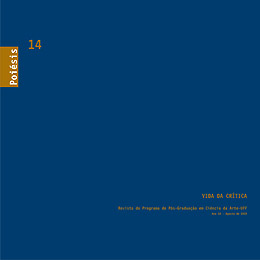O faroeste em John Ford e Glauber Rocha: a verdade e o mito da imagem
DOI:
https://doi.org/10.22409/poiesis.1014.102-113Keywords:
cinema, Glauber Rocha, John FordAbstract
Este artigo visa estudar como o retrato do gênero faroeste, nos filmes O homem que matou o facínora, de John Ford e Deus e o diabo na terra do sol, de Glauber Rocha, pode questionar a verdade, no sentido iluminista, teleológico, que uma imagem carrega, ou pretende carregar. Utilizo como apoio para minha reflexão os livros sobre cinema de Gilles Deleuze, Imagem-tempo e Imagem-movimento.Downloads
References
Bakhtin, M. (2006). Marxismo e filosofia da linguagem. São Paulo: HUCITEC.
Bazin, A. (1991). “Ontologia da imagem fotográfica” in: Cinema: Ensaios. São Paulo: Brasiliense.
Deleuze, G. (1999). Imagem-tempo. São Paulo: Brasiliense.
______________. (1985). Imagem-movimento. São Paulo: Brasiliense.
Ferreira, J. (2000). Cinema de invenção. São Paulo: Limiar.
Pasolini, P. P. (1986) “Cinema de prosa e cinema de poesia” in: Diálogos com Pasolini: Escritos (1957-1984). São Paulo: Nova Stella
Downloads
Published
How to Cite
Issue
Section
License
Authors who publish in Revista Poiésis agree to the following terms:
- The authors keep the copyright and grant the journal the right of first publication. The work is automatically licensed under the Creative Commons Attribution License, which enables its sharing as long as the authorship and initial publication in this journal are acknowledged.
- Authors are allowed and encouraged to distribute online their work published in Revista Poiésis (in institutional repositories or in their own personal page), since this can generate productive interactions, as well as increase the impact and citation of the published work (See The Effect of Free Access).


